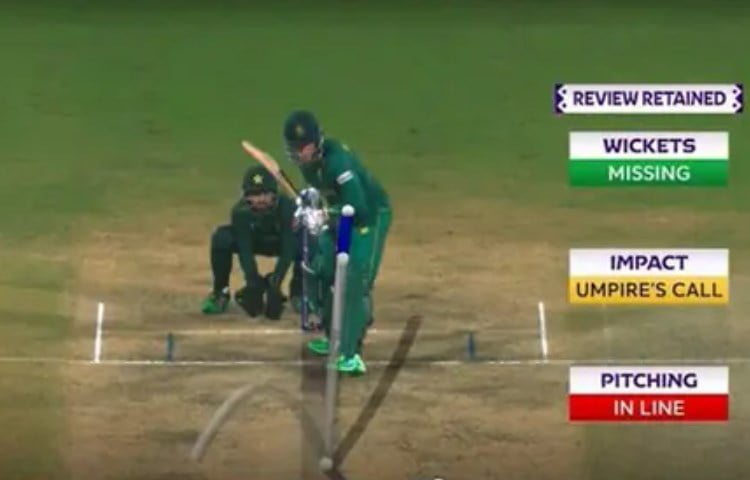The International Cricket Council (ICC) issued a clarification after a highly controversial LBW decision against Rassie van der Dussen during the World Cup match between Pakistan and South Africa in Chennai on Friday. Van der Dussen was given out on the field by umpire Paul Reiffel in the 19th over of South Africa’s chase, but two different ball-tracking replays were shown on DRS, leading to confusion and outrage among fans.

The first ball-tracking replay showed the ball missing the leg stump, but the second replay showed the ball clipping the stump. The ICC has now clarified that the first graphic was shown “erroneously” and that the second graphic was the correct one. However, many fans remain unconvinced, arguing that the DRS system is unreliable and that van der Dussen was wrongly given out.
DRS was also under the scanner towards the end of the match, when Pakistan pacer Haris Rauf trapped South Africa’s last batter Tabraiz Shamsi in front of the stumps. Umpire Alax Wharf adjudged the decision not out, but Pakistan immediately went for a review.
ALSO READ: Tabraiz Shamsi’s Controversial LBW Decision Sparks DRS Debate Among Netizens
Replays showed the ball pitching in line and the impact in line, but the DRS ball-tracking projected that the ball would have come in sharply with the angle and instead of smashing onto the stumps, it would have clipped it. As soon as “umpire’s call” flashed on the big screen, the Pakistan players were distraught.
South Africa went on to win the match by one wicket, but the two controversial DRS decisions have raised serious questions about the reliability of the system. The ICC needs to address these concerns as soon as possible to ensure that fans can have confidence in the fairness of the game.
@TinusvS4 Did you see this? DRS shows Rassie is not out and then resets and then shows out? Who’s is verifying DRS and how does such mistakes happen? pic.twitter.com/1PjIKkdfvz
— WhatWouldKallisSay (@WhatKallisSaid) October 27, 2023
The two controversial DRS decisions in the Pakistan vs South Africa match have highlighted the need for the ICC to review its DRS protocols. The fact that two different ball-tracking replays were shown for van der Dussen’s LBW decision is unacceptable. The ICC needs to ensure that there is a single, definitive ball-tracking system that is used for all DRS reviews.
The DRS decision against Shamsi was also controversial, as the ball appeared to be clipping the leg stump. The ICC needs to clarify why the DRS ball-tracking projected that the ball would have missed the stumps.
WATCH – Marco Jansen And Mohammad Rizwan Have Heated Exchange In Chennai
The ICC also needs to address the issue of “umpire’s call”. Currently, if the DRS ball-tracking shows that the ball is pitching in line and the impact is in line, but the umpire has given the decision either way, the on-field decision is upheld. This is unfair to the batting team, as it can lead to batsmen being wrongly given out.
The ICC should consider changing the “umpire’s call” rule so that batsmen are only given out if the DRS ball-tracking shows that the ball is definitely going to hit the stumps. The ICC needs to take steps to address the concerns that have been raised about the DRS system. Otherwise, fans will lose confidence in the fairness of the game.
